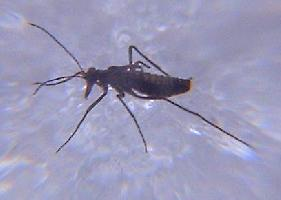
Greutăți și măsuri
| Lungime | 4 mm |
|---|
Date biologice
| Durata de viață | 6 m |
|---|
Descrierea animalului
The Snow Scorpionfly, scientifically known as Boreus hyemalis, is a fascinating insect that thrives in cold environments, primarily found in the Northern Hemisphere, including parts of North America and Europe. This species belongs to the family Boreidae, under the order Mecoptera, which encompasses scorpionflies and their relatives. However, despite its common name, the Snow Scorpionfly does not possess the scorpion-like tail that is characteristic of true scorpionflies. Instead, its appearance and behavior set it apart, making it a unique subject of study in the entomological world.Measuring about 6 mm in length, Boreus hyemalis has a dark, mossy green or brown body, which provides excellent camouflage against the moss and lichen-covered habitats it frequents. One of the most remarkable features of this insect is its adaptation to cold climates. Unlike many other insects that are dormant during winter, the Snow Scorpionfly is most active during this season, particularly adept at moving across snow surfaces, which is a rare trait among insects.
The wings of Boreus hyemalis are greatly reduced, making them incapable of flight. Instead, they are equipped with long legs that enable them to jump efficiently, a mode of locomotion that is well-suited to their snowy environment. This adaptation allows them to evade predators and to move quickly in search of food and mates during the winter months.
The diet of the Snow Scorpionfly primarily consists of moss, with a particular preference for the spores, as well as dead and decaying plant matter. This dietary preference further underscores their ecological role in nutrient recycling within their habitats.
Reproduction in Boreus hyemalis occurs during the cold months, a rare phenomenon among insects. Males are known to attract females through a combination of pheromones and possibly visual cues. Once mating is concluded, females lay their eggs in moss, where the larvae will develop. The larvae are also well-adapted to the cold, feeding on moss until they pupate and eventually emerge as adults. This life cycle, closely tied to the cold, ensures that Snow Scorpionflies are a prominent feature of their ecosystems during winter.
In terms of conservation status, Boreus hyemalis does not currently face any significant threats. However, like many other species, they could be affected by climate change, especially global warming, which could alter their snowy habitats and impact their survival.
In summary, the Snow Scorpionfly, Boreus hyemalis, is a unique insect with remarkable adaptations to cold weather. Its presence in winter landscapes, dietary habits, and reproduction cycle make it an intriguing subject for entomologists and nature enthusiasts alike. As an integral part of its ecosystem, understanding and preserving this species is essential for maintaining the ecological balance within its natural habitat.
Fotografii noi cu animale
Top 10 animale
- Dolphin gull (Leucophaeus scoresbii)
- Diana monkey (Cercopithecus diana)
- Galápagos tortoise (Geochelone nigra complex)
- Moustached guenon (Cercopithecus cephus)
- Japanese spider crab (Macrocheira kaempferi)
- Colossal squid (Mesonychoteuthis hamiltoni)
- Stone loach (Barbatula barbatula)
- Fox tapeworm (Echinococcus multilocularis)
- Japanese macaque (Macaca fuscata)
- Barbary macaque (Macaca sylvanus)